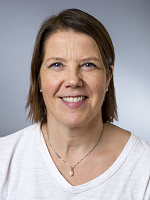Imagine not being able to stay outdoors during winter. Or having to put on gloves to open the fridge. New knowledge and better treatment give hope to people who suffer from a rare cold disease.

People who suffer from a rare cold disease can experience great pain and serious health damage from the cold. Illustration image: Colourbox.com
For most of us, feeling a little cold is not a big issue. This is a different story for people who suffer from a rare cold disease. They can experience a lot of pain, become anaemic and suffer serious damage to their health from the cold. Even small changes in temperature can make the disease flare up, and many patients have symptoms even when they are not feeling cold.
Researchers estimate that 100 people suffer from this disease in Norway. Most often, the disease is discovered when patients are in their 70s, while in some cases it is discovered in people as young as 40 years old.

The disease is called chronic cold agglutinin disease (CAD) and is a disease of the bone marrow. For a long time, no one knew about it, and it was not acknowledged as a disease. However, recent discoveries have provided new knowledge about its causes, and it is now on the World Health Organization's list of diseases.
"The fact that we now know more about the mechanisms behind the disease, what happens in the body and why, means that patients can receive more targeted treatment," Ulla Randen says. She is an associate professor at the Institute of Clinical Medicine at the University of Oslo.
Patients used to get other diagnoses and treatments
Since researchers and clinicians did not know about the mechanisms behind the rare cold disease and it was not recognised as a disease, it was difficult to treat patients.
"In the past, patients have been diagnosed incorrectly, with everything from lymphoma to autoimmune diseases. They received treatments for those diagnoses. However, the treatments did not achieve the desired effect in these patients. The treatments also have a number of side effects," Randen says and adds:
"Some patients did not receive any diagnosis at all."
Discovered that it is a disease of its own
Ulla Randen therefore wanted to study the condition and get to the bottom of what the patients were suffering from.
"We discovered that this disease differs from known forms of lymphoma and other types of reactive conditions. We went on to describe and reclassify the disease," she says.
Cooling activates antibodies in the blood
Many of us may have a few antibodies in our blood called cold agglutinins. For the most part, they do not cause problems. However, patients with CAD have many such antibodies, which is abnormal.
In patients, the antibodies are activated when the blood cools down. When that happens, the blood begins to clot or agglutinate, as it is also called.
"When this occurs, the blood cannot circulate all the way to the smallest blood vessels in the fingertips, toes, in the ears and on the tip of the nose. These body parts therefore become bluish-white and painful because you don't have blood circulation there," the associate professor explains.
For those affected, only small changes in temperature can activate these antibodies. A smaller temperature drop, such as the temperature in the blood falling below 32 degrees Celsius, may be enough. This can occur when patients get cold, but also under normal conditions when the blood passes through the outer parts of the head, arms and legs.
As a result, the antibodies can cause trouble even when it is not particularly cold.
"We looked at the blood and bone marrow samples of patients in Norway and found that everyone had a group of immune cells that produce these antibodies," Ulla Randen says.
Many become anaemic and need a blood transfusion
The clots in the blood dissolve again when the blood returns to warmer parts of the body.
"The problem is that the red blood cells get a small tag on them when they clot. The cleansing systems in the liver and spleen recognise the tag and destroy the blood cells. Since this cleansing system constantly destroys blood cells, patients become anaemic, i.e., they lose red blood cells," she explains.
Half of the patients with CAD that suffer from anaemia need blood transfusion.
Treatment with immunotherapy has a good effect
With these new discoveries, patients can receive better treatment. One type of immunotherapy has proven to have a good effect in most people who are affected, according to Randen.
"There is a drug called Rituximab that attacks the population of immune cells that make the body produce the abnormal antibodies," she says.
In addition, patients get various combinations of chemotherapy.
The aim of the treatment is to remove the immune cells that make abnormal antibodies.
"This treatment had a very good effect. Seven out of ten patients could lead a more normal life," she says.
Some patients could finally go skiing again
The new treatment improves patients' quality of life greatly. Many feel their energy is back and can spend time outdoors without pain or symptoms even when it is cold.
"Some patients could finally go skiing again!" the researcher says.
So far, the effects of the treatment seem to last over time.
"But we do not know if patients are completely cured. With new immunotherapy, some people report that the disease disappears completely. However, these kinds of diseases are a bit insidious. There may be some cells hiding somewhere, which means that the disease can flare up again," Randen points out.
Different treatment options
There are several possible treatments for CAD. Sigbjørn Berentsen has conducted research on several types of treatment and has treated many patients with the disease. He is one of the clinicians who has collaborated with Ulla Randen.
The treatment with immunotherapy and chemotherapy does not turn out equally for everyone who has cold agglutinin disease, he explains.
"The possible disadvantage of chemotherapy is that you may shut down the immune system completely. Then there is a risk of different types of infections," Berentsen says.
Doctors must assess the general health of each patient and weigh treatment options against how much they are affected by the disease, he explains.
"Elderly, frail patients should in some cases be given a milder version of the treatment. Other patients have so few and mild symptoms that they do not need treatment. In those cases, we go for a "watch and wait" option and follow up on the patient over time to see how the disease develops," Berentsen explains.
The first time they collect data from patients
"No one had actually collected all the data that we had on patients in Norway until we started working on this project. Since this is a small patient group, we need to collect all the data that we can access, in order to do different analyses," Randen says.
The researchers collected bone marrow samples, both tissue samples and cells that are collected from the bone marrow with a syringe. The researchers could then look at a single cell at a time. The method they used is called flow cytometry.
"This is a method by which you recognise different cell types and count them. By using this, we discovered that these were separate clones, or identical groups, of immune cells. We also did genetic analyses to check if the antibodies were the same. Under the microscope, we could see that they differ from the clones known from other types of lymphoma and reactive conditions. This is how we ended up discovering that we were talking about a separate disease," the associate professor explains.






